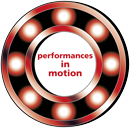Linear bearings
The linear technology can in principle be compared with the technology of roller bearings, although the movement patterns differ in case of linear bearings. The roller bearings function rotatorily, in case of linear bearings the parts moving analogously in order to convey the force work translationally, which means in a linear movement. Figuratively seen, one can imagine a linear bearing as a roller bearing which is unwound in the plane. Both tracks are parallel to each other and the respective roller bearing is located in the gap; the roller bearing in this case consists of either balls or rolls. The transmission of the force in the rolling contact takes place analogously to the roller bearing, whereby the unwanted contacts with machine parts are also prevented. The difference is manifested in the rotation of the rolling elements, tracking and return take place in case of linear technology by virtue of a linear motion.
Different determinations of service life of linear bearings and roller bearings
Other differences between functions of these two types of bearings arise from the determination of service life. In case of roller bearings, the number of revolutions or operating hours is calculated, whereas in case of linear technology, the distance travelled is taken as a basis of the calculation. On the other hand, two variants have many things in common, such as for instance, use of materials already proven in roller bearings in linear technology as well, and the lubrication and sealing are also similar.
Linear bearings - or also linear ball bearings are possible in several versions, slide bearings being one of them, where the runs take place analogously to rotational slide bearings. The disadvantage in this case is manifested in a greater bearing play as opposed to the roller bearings. Furthermore: Linear bearings are colloquially often referred to as linear bushings.
Application of linear bearings
Linear bearings can be used, for instance, in printing machines, flame cutting machinery, all types of presses, as well as in computers and measurement devices. Linear bearings are also used for constructing sliding devices such as linear tables. The purpose of linear bearings in this case is constantly friction-free guiding of a straight-line motion of an element of a machine, which actually represents the key difference between linear bearings and ball bearings.
In principle, the term of linear technology goes beyond the plain force transmission, drive components are also integrated in the area of guiding elements, in which difference is made between rotational drives (toothed belt drive) and linear drives (ball screw drive or roller drive) The linear technology in this case is normally characterised by a limited stroke.
Linear bearings are manufactured by e.g. SKF or FAG. Braun will gladly be at your disposal around the clock and provide information on its extensive assortment and thus ensure the correct selection of the bearing type.
We have compiled and checked all data, but can not accept liability for any errors or omissions.





